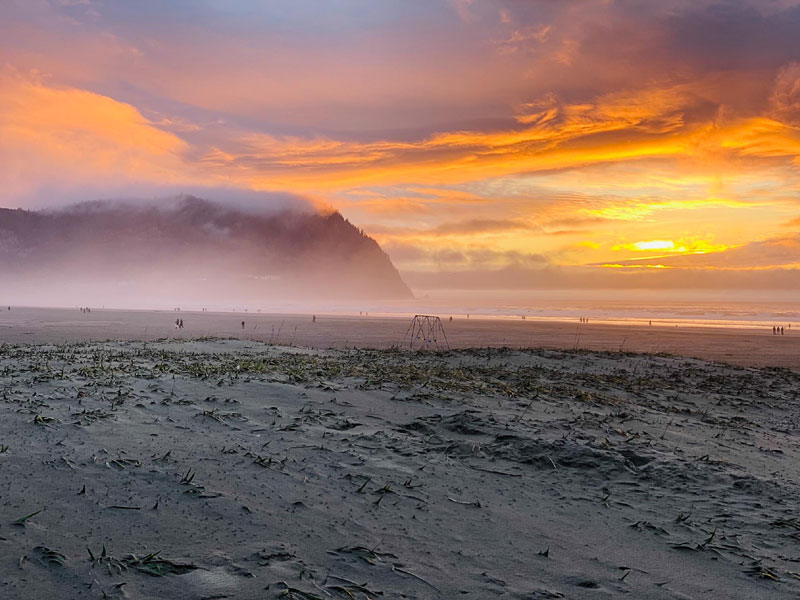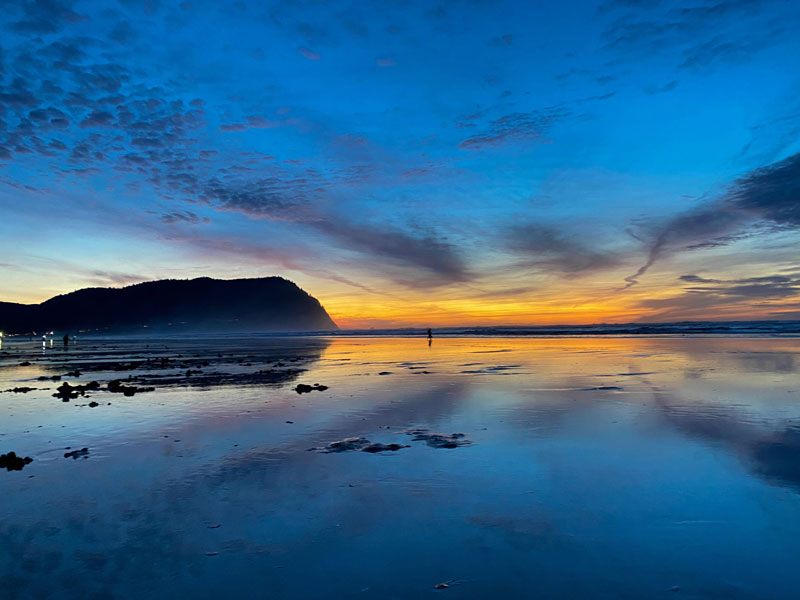Brown Waves Return to N. Oregon Coast. Could It Mean Glowing Waves?
Published 12/06/21 at 5:52 PM PST
By Oregon Coast Beach Connection staff

Includes exclusive listings; some specials in winter
In Cannon Beach:
Includes rentals not listed anywhere else
In Manzanita, Wheeler, Rockaway Beach:
Some specials for winter
In Pacific City, Oceanside:
Some specials for winter
In Lincoln City:
Some specials for winter
In Depoe Bay, Gleneden Beach:
Some specials for winter
In Newport:
Look for some specials
In Waldport
Some specials for winter
In Yachats, Florence
Some specials for winter
Southern Oregon Coast Hotels / Lodgings
Reedsport to Brookings, places to stay; winter deals
(Seaside, Oregon) – More fun, oceanic weirdness is on display on the north Oregon coast – or at least it was until the rains hit. (All photos courtesy Seaside Aquarium)
Tiffany Boothe of Seaside spent the pleasant weather weekend beachcombing and made at least one interesting discovery: brown waves are again in the Seaside area.
Boothe also managed to capture some exceptional sunset shots in recent weeks, which she shared with Oregon Coast Beach Connection.
On the ground, however, there's another wacky show going on. Brown waves in the Seaside to southern Washington coast area mean something interesting is happening: lots and lots of phytoplankton.
No, it's not pollution – a presumption many jump to, especially if those waves get oddly gooey and oily-looking. It's actually a good thing, according to Boothe and Seaside Aquarium manager Keith Chandler. The culprit are tiny forms of algae called phytoplankton, which you might remember are the bottom of the food chain in the ocean, something that just about everything feeds on.

“Diatoms are single-celled plants (phytoplankton) that are found in both fresh and salt water,” Boothe said. “They are one of the most important food sources in the ocean. In the winter, spring, and early summer, diatoms rapidly multiply in the surf zone. Diatoms absorb large amounts of nitrates and phosphates that are delivered to the ocean by coastal rivers, contributing to their population explosion.” [Freaky, Gooey Brown Waves Again on Washington, Oregon Coast, Video ]
When waters here turn brown, it simply means there are so many of them. It's a phenomenon that doesn't really happen on the south coast or central Oregon coast – really just the Seaside to Warrenton area and parts of the south Washington coast.
Scientists say it has something to do with all the right nutrients coming down the Columbia River.
“It's not really so much of a stain as it is a lot of the stuff accumulates on the beaches,” Chandler said. “The stuff, like the brown bubbles, feels a little oily, but that doesn't mean it is oil. It just comes from a lot of it piling on the beaches. The tide will come and clean it out. Just like a ketchup stain – it comes right out.”

Diatoms are also the basic foundation for bubbles in the surf anywhere on the Oregon and Washington coast. That sea foam you find, sometimes in huge, snow-like clumps, is essentially made up of one kind of phytoplankton or another.
It's actually their skeletons (yes, they're microscopic, so there's billions of them just around you) that interact with the sea water and create a kind of viscosity, causing the tiny forms to blow bubbles out of the churning ocean. [Oregon Coast Science Experts: What is Sea Foam? ]
Another exceptionally cool thing about lots of brown waves at Seaside? It can be a portent for something else: glowing sands. If there are so many diatoms out there, then chances are decent there's a big bloom of dinoflagellates as well, the form of phytoplankton that is bioluminescent. Bioluminescent Phytoplankton: What Makes Glowing Sand On Oregon Coast, Washington
This would be a good time to check the Washington coast or north Oregon coast at night for glowing sand or glowing waves, but rainfall usually kills these creatures out, certainly on the beaches. If brown waves persist when the weather clears, then you'll want to check those beaches after dark.
Below are more photos, including Boothe's exceptional captures of recent sunsets in Seaside.
Hotels in Astoria/Seaside - Where to eat - Astoria Maps and Virtual Tours
Cannon Beach Lodging
Nehalem Bay Lodgings
Manzanita Hotels, Lodging
Three Capes Lodging
Pacific City Hotels, Lodging
Lincoln City Lodging
Depoe Bay Lodging
Newport Lodging
Waldport Lodging
Yachats Lodging
Oregon Coast Vacation Rentals
Oregon Coast Lodging Specials



More About Oregon Coast hotels, lodging.....
More About Oregon Coast Restaurants, Dining.....
LATEST Related Oregon Coast Articles
Bringing the Lincoln City events back to their roots
4.5 Quake Off S. Oregon Coast After A Week of Smaller Ones
Quakes on Dec. 15, 17, 20 and last night off Coos Bay, Bandon. Geology
Final Third of Oregon Coast Given Okay to Start Commercial Crabbing
Majority of the coast began crabbing last week. Marine sciences
Lassoing a Wayward Sea Lion Just Part of the Gig for Oregon Coast Deputies
Sea lion wandering near Newport / South Beach streets got some interesting looks. Marine sciences
Various Oregon Coast Road Issues At Least Partially Solved, Including OR 6
Hwy 6, 101 near Neskowin, others at least partially open. Tillamook, Coos Bay, Bandon. Traffic
Variety of Oregon State Parks Closed Due to Storm, from Coast to Columbia Gorge
Silverton, Estacada, Coastline and others: several parks damaged or closed. Weather
Flood Warnings Extended Into Afternoon Around Oregon, the Coast
Rivers near Lincoln City, Tillamook, Molalla, others at flood stage; wind damage
Winter Solstice and What It Brings to Oregon / Washington Coast Sunsets
Dec 21 is the solstice, bringing longer days and a sunset surprise. Weather
Back to Oregon Coast
Contact Advertise on BeachConnection.net
All Content, unless otherwise attributed, copyright BeachConnection.net Unauthorized use or publication is not permitted



















































